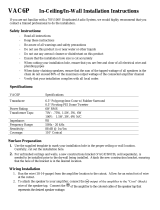
2
TD-000264-00-E
EXPLANATION OF SYMBOLS
The term “WARNING!” indicates instructions regarding personal safety. If the instructions are not followed the result may be bodily injury or death.
The term “CAUTION!” indicates instructions regarding possible damage to physical equipment. If these instructions are not followed, it may result in
damage to the equipment that may not be covered under the warranty.
The term “IMPORTANT!” indicates instructions or information that are vital to the successful completion of theprocedure.
The term "NOTE" is used to indicate additional useful information.
The intent of the lightning flash with arrowhead symbol in a triangle is to alert the user to the presence of un-insulated "dangerous"
voltage within the product's enclosure that may be of sufficient magnitude to constitute a risk of electric shock to humans.
The intent of the exclamation point within a triangle is to alert the user to the presence of important safety, and operating and
maintenance instructions in this manual.
IMPORTANT SAFETY INSTRUCTIONS
1. Read these instructions
2. Keep these instructions.
3. Heed all warnings.
4. Follow all instructions.
5. Do not use this apparatus near water.
6. Clean only with a dry cloth.
7. Do not install near any heat sources such as radiators, heat registers, stoves, or other apparatus (including amplifiers) that produce heat.
8. Only use attachments/accessories specified by the manufacturer.
9. Refer all servicing to qualified service personnel. Servicing is required when the apparatus has been damaged in any way, such as
power-supply cord or plug is damaged, liquid has been spilled or objects have fallen into the apparatus, the apparatus has been exposed to
rain or moisture, does not operate normally, or has been dropped.
10. Do not use this apparatus in or near water or liquids.
11. Adhere to all applicable, local codes.
12. Consult a licensed, professional engineer when any doubt or questions arise regarding a physical equipment installation.
WARNING!: Before placing, installing, rigging, or suspending any speaker product, inspect all
hardware, suspension, cabinets, transducers, brackets and associated equipment for damage. Any
missing, corroded, deformed or non-load rated component could significantly reduce the strength
of the installation, placement, or array. Any such condition severely reduces the safety of the
installation and should be immediately corrected. Use only hardware which is rated for the loading
conditions of the installation and any possible short-term unexpected overloading. Never exceed
the rating of the hardware or equipment. Consult a licensed, professional engineer when any doubt
or questions arise regarding a physical equipment installation.
Maintenance and Repair
Advance technology, e.g., the use of modern materials and powerful electronics, requires specially adapted maintenance and repair methods. To
avoid a danger of subsequent damage to the apparatus, injuries to persons and/or the creation of additional safety hazards, all maintenance or
repair work on the apparatus should be performed only by a QSC authorized service station or an authorized QSC International Distributor. QSC is
not responsible for any injury, harm or related damages arising from any failure of the customer, owner or user of the apparatus to facilitate those
repairs.










